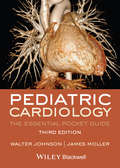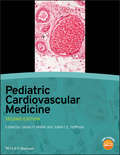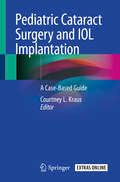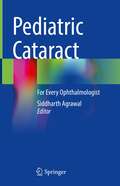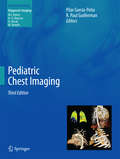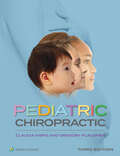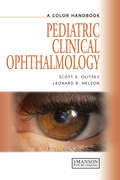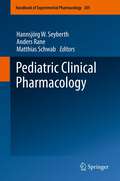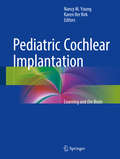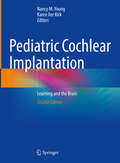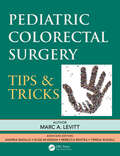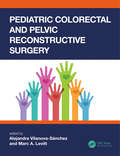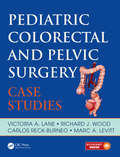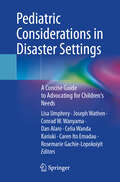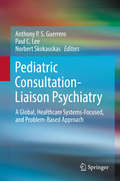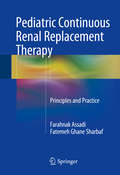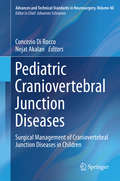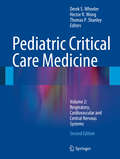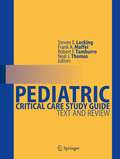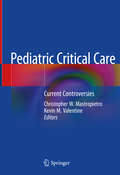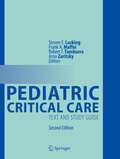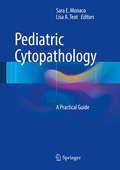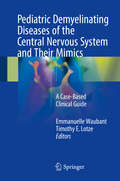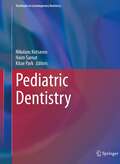- Table View
- List View
Pediatric Cardiology: The Essential Pocket Guide (Core Handbook Series In Pediatrics)
by James H. Moller Walter H. JohnsonCaring for children with heart disease is extremely complex, requiring a different and often tailor-made approach compared with adults with similar cardiac problems. Built on the success of previous editions and brought to you by a stellar author team, Pediatric Cardiology: The Essential Pocket Guide provides a unique, concise and extremely practical overview of heart disease in children. From history-taking, physical examination, ECG, and chest X-ray – the basics that enable clinicians to uncover possible problems and eliminate areas of false concern – it goes on to examine the range of more complex topics in the diagnosis and treatment/management of childhood cardiovascular disease. New to this edition you’ll find: An enhanced section on imaging including recent advances in cardiac MRI and fetal echocardiography. New techniques in genetic testing for heart disease in special populations. Much more emphasis on the importance of echocardiography in understanding the pathophysiology of congenital cardiac malformations. Expanded section on cardiac conditions in the neonate, specifically on prenatal diagnosis and management, neonatal screening for congenital heart disease, and hypoplastic left heart syndrome. Expanded and updated congestive cardiac failure section, including the latest in genetic and metabolic causes of heart failure, and medical/surgical treatment options; discussion of bridging therapies; essentials of transplantation, including common drug treatment regimens, clinical recognition of treatment complications and rejection, outcomes, morbidity and survival. In addition, every chapter is fully updated with the very latest clinical guidelines and management options from the AHA, ACC and ESC. Pediatric Cardiology: The Essential Pocket Guide, 3rd edition, is quite simply a must-have guide for all members of the multidisciplinary team managing children suffering from heart disease.
Pediatric Cardiovascular Medicine
by James H. Moller Julien I. HoffmanThe first edition of this text, edited by two of the world's most respected pediatric cardiologists, set the standard for a single-volume, clinically focused textbook on this subject. This new edition, revised and updated by contributors representing today's global thought leaders, offers increased coverage of the most important current topics, such as pediatric electrophysiology, congenital heart disease, cardiovascular genetics/genomics, and the identification and management of risk factors in children, while maintaining the clinical focus. Published with a companion website that features additional images for download, self-assessment questions designed to aid readers who are preparing for examinations, and other features, Pediatric Cardiovascular Medicine, Second Edition, is the perfect reference for residents, fellows, pediatricians, as well as specialists in pediatric cardiology.
Pediatric Cataract Surgery and IOL Implantation: A Case-Based Guide
by Courtney L. KrausPediatric Cataract Surgery and IOL Implantation: A Case Based Guide is a must-have resource for ophthalmologists, surgeons, residents, and fellows who work with pediatric cataracts and their surgical management as well as ancillary readers such as parents or supportive caregivers to a child with cataracts.This book offers a comprehensive overview of the epidemiology of pediatric cataract surgery and considerations surrounding IOL implantation. It addresses pre-operative evaluation and examination, as well as surgical steps and techniques for various pediatric cataract conditions. Chapters begin with an introduction and are followed by discussions that offer expert viewpoints and case studies. In addition, chapters illustrate the complexity of the management of pediatric lens opacities. The book closes with a case-based approach to special considerations in IOL implantation: including considerations in the uveitic patient, placement without capsular support, and cataract surgery in the developing world. Providing thoughtful chapters that seek to expand on the currently available literature without redundancy, this book a solid companion piece to any other text discussing pediatric cataracts.
Pediatric Cataract: For Every Ophthalmologist
by Siddharth AgrawalThe book covers all clinical aspects of pediatric cataract surgery. Chapters cover basic sciences, etiology, pre-operative evaluation, choice of intraocular lenses, steps of surgery, complications, considerations in traumatic cataract and post-operative rehabilitation. It includes photographs, diagrams, flow charts and tables for easy memorization and understanding. Multiple choice questions at the end of each chapter help to evaluate the understanding and reinforce important concepts.The book aims to encourage ophthalmic surgeons to successfully treat children with cataract as all of them perform adult cataract surgeries but usually avoid managing pediatric cases. This hesitation is primarily due to exhaustive pre-operative evaluation and long term follow up. As a result the back log of this disease in the developing world is significant and many such children are unable to receive timely intervention during their crucial period of visual development. The chapters primarily focus on the clinically relevant issues to keep the reader interested. The book includes contributions from some of the most talented and experienced pediatric cataract surgeons.The book is relevant for ophthalmologists not commonly practicing pediatric cataract surgery and post graduate students.
Pediatric Chest Imaging
by Pilar García-Peña R. Paul GuillermanSince the second edition of Pediatric Chest Imaging was published in 2007, there have been further significant advances in our understanding of chest diseases and continued development of new imaging technology and techniques. The third, revised edition of this highly respected reference publication has been thoroughly updated to reflect this progress. Due attention is paid to the increased role of hybrid imaging, and entirely new chapters cover topics such as interventional radiology, lung MRI, functional MRI, diffuse/interstitial lung disease, and cystic fibrosis. As in previous editions, the focus is on technical aspects of modern imaging modalities, their indications in pediatric chest disease, and the diagnostic information that they supply. Pediatric Chest Imaging will be an essential asset for pediatricians, neonatologists, cardiologists, radiologists, and pediatric radiologists everywhere.
Pediatric Chiropractic
by Claudia A. Anrig Gregory PlaugherThe long-awaited third edition of Pediatric Chiropractic takes the valuable second edition to a whole new level, offering new chapters, full-color photos, illustrations, and tables to provide the family wellness chiropractor and the student of chiropractic a valuable reference manual covering all aspects of care for the pediatric and prenatal populations. Internationally recognized authorities Claudia Anrig, DC and Gregory Plaugher, DC have invited the leaders in their fields to contribute to this precedent-setting textbook and now offer even more valuable information for the practitioner.
Pediatric Clinical Ophthalmology: A Color Handbook
by Leonard Nelson Scott OlitskyThis clinically oriented volume reviews the signs, symptoms and treatment of common ocular diseases and disorders in infants and children. Ocular disorders are of major significance as they often provide clues to the presence, not only of systemic diseases, but also of other congenital malformations. By means of concise text supported by a wealth o
Pediatric Clinical Pharmacology
by Anders Rane Hannsjörg W. Seyberth Matthias SchwabThe objective of this volume is to give an overview of the present state of the art of pediatric clinical pharmacology including developmental physiology, pediatric-specific pathology, special tools and methods for development of drugs for children (assessment of efficacy, toxicity, long-term safety etc.) as well as regulatory and ethical knowledge and skills. In the future, structural and educational changes have to lead back to a closer cooperation and interaction of pediatrics with (clinical) pharmacology and pharmacy.
Pediatric Cochlear Implantation
by Nancy M Young Karen Iler KirkThis book will move the field of pediatric cochlear implantation forward by educating clinicians in the field as to current and emerging best practices and inspiring research in new areas of importance, including the relationship between cognitive processing and pediatric cochlear implant outcomes. The book discusses communication practices, including sign language for deaf children with cochlear implants and the role of augmentative/alternative communication for children with multiple disabilities. Focusing exclusively on cochlear implantation as it applies to the pediatric population, this book also discusses music therapy, minimizing the risk of meningitis in pediatric implant recipients, recognizing device malfunction and failure in children, perioperative anesthesia and analgesia considerations in children, and much more. Cochlear Implants in Children is aimed at clinicians, including neurotologists, pediatric otolaryngologists, audiologists and speech-language pathologists, as well as clinical scientists and educators of the deaf. The book is also appropriate for pre-and postdoctoral students, including otolaryngology residents and fellows in Neurotology and Pediatric Otolaryngology.
Pediatric Cochlear Implantation: Learning and the Brain
by Karen Iler Kirk Nancy M. YoungThis second edition text will provide updated information to professionals and students in fields relevant to cochlear implantation. The main objective of this book is to provide the latest information about pediatric candidacy evaluation, medical and vestibular evaluation, surgery, language and literacy outcomes, habilitation, spatial hearing, influence of family dynamics and educational needs. This text also expands upon newer indications including unilateral and asymmetric hearing loss, management of children with residual hearing, and management of children from families whose primary language is Spanish. Additional important new topics discussed include the role of interprofessional training to better serve children, the Australian hearing health care model to achieve early implantation and addressing global barriers to pediatric implantation. Pediatric Cochlear Implantation is ideal for both trainees and practicing otolaryngologists, otologists/neurotologists, audiologists, speech language pathologists, psychologists and educators who work with deaf and head of hearing children.
Pediatric Colorectal Surgery: Tips & Tricks
by Marc A. LevittBased on 30 years of experience as a surgeon working in the field of pediatric colorectal and pelvic reconstructive surgery, author Marc Levitt shares the tips and tricks that he has developed to make operations and patient management easier and reproducible. This book teaches these skills to achieve positive results. Patients with anorectal malformations (ARMs), Hirschsprung disease (HD), fecal incontinence from a variety of conditions, colonic motility disorders, and a myriad of other conditions comprise the field of pediatric colorectal and pelvic reconstruction. Such patients require care throughout their lives from specialists across numerous fields, which may include colorectal surgery, urology, gynecology, and GI motility, as well as specialized nursing, orthopedics, neurosurgery, anesthesia, pathology, radiology, psychology, social work, and nutrition. Sometimes the field can seem chaotic and unpredictable. Reconstruction requires creativity and at times it feels that artwork is being created during the actual operation with no pre-plan in mind. Marc Levitt and his colleagues have worked very hard to counter that feeling, to be fully prepared, and to develop protocols, techniques, and processes that can be adopted by other clinicians, so that optimal results for patients can be achieved. This book reflects both this experience and this approach.
Pediatric Colorectal and Pelvic Reconstructive Surgery (Pediatric Colorectal Surgery)
by Alejandra Vilanova-Sánchez and Marc A. LevittThis book provides comprehensive coverage of the anatomical and physiological aspects of complex colorectal and pelvic malformations. Also described are the surgical protocols for this specialized field within pediatric surgery. The benefits of high-level collaboration between surgical services when treating these anomalies are explained, as are treatment algorithms and care of complications. Includes evaluation and management of the newborn Describes surgical interventions of the newborn, and when a primary repair versus a staged approach is required Explains the value of laparoscopy and deciding in which cases to use it Looks at the importance of a transition program to adulthood Pediatric surgeons worldwide and the teams in which they work will benefit from this well illustrated and comprehensive work.
Pediatric Colorectal and Pelvic Surgery: Case Studies
by Richard J. Wood Victoria A. Lane Carlos ReckThis new handbook teaches and explains the key principles in the management of complex pediatric colorectal diagnoses. By using case-based presentations, radiographic images, operative images with Multiple Choice Questions to test knowledge, this book serves as an invaluable educational tool. ‘Learning Points’ are included and the text includes comprehensive explanatory chapters. The 60 cases included encompass the full range of pediatric conditions, and the additional learning material completes this unique handbook. The e-book further enhances the learning experience for all clinicians involved in the treatment of children suffering from colorectal disorders.
Pediatric Considerations in Disaster Settings: A Concise Guide to Advocating for Children's Needs
by Lisa Umphrey Joseph Wathen Conrad W. Wanyama Dan Alaro Celia Wanda Kariuki Caren Ito Emadau Rosemarie Gachie-LopokoiyitMan-made and natural disasters—including armed conflict, environmental catastrophes, forced displacements, and epidemics—affect thousands worldwide each year, causing loss of homes, livelihoods, and possessions. Complex humanitarian emergencies are increasing due to international conflict and civil war. The COVID-19 pandemic further underscored the need for efficient and equitable disaster responses, particularly for those in low- and middle-income countries. Pediatric-specific considerations in disaster response, especially in humanitarian emergencies and resource-constrained settings already burdened by preventable illness and limited healthcare access, remain an often overlooked yet critical component. Children make up a disproportionately large percentage of disaster victims due to their developmental and physical vulnerabilities. Those with complex healthcare needs or disabilities are at even greater risk. The devastating consequences of gaps in preparedness and response have also been demonstrated in well-resourced settings, as seen with Hurricane Katrina. Previous research has called for better training for medical trainees and disaster relief workers to improve pediatric disaster preparedness. Yet, programs specifically addressing children's needs are in short supply, and relief workers often lack the expertise to provide appropriate care. There is also a persistent gap in guidelines advocating for children&’s unique needs in disaster settings. This book seeks to address these gaps. Written by experts in the field, Pediatric Considerations in Disaster Settings is a multi-institutional, multi-author collaboration representing perspectives from around the globe. This book summarizes evidence-based guidelines and real-world experiences from professionals who have cared for children in disaster settings across various resource contexts. It addresses an urgent need for guidance in recent and ongoing conflicts and disasters, equips healthcare professionals and public health workers with the skills to collaborate effectively in disaster response, and educates readers on adapting interventions and advocacy strategies to meet children&’s unique needs in any resource setting.
Pediatric Consultation-Liaison Psychiatry: A Global, Healthcare Systems-Focused, and Problem-Based Approach
by Anthony P. Guerrero Paul C. Lee Norbert SkokauskasThis ambitious resource presents an inventive approach to integrating pediatric and mental health care based in comprehensive, family-centered service delivery. Its framework adds a problem-solving focus to the core principles of pediatric consultation-liaison psychiatry, emphasizing young patients’ developmental, family, and social context. An international panel of expert clinicians explores the value of the mental health component in treating complex and chronic cases across varied settings, as well as practical considerations in implementing collaborative pediatric care systemwide, including at the global level. Detailed case histories illustrate skills and traits essential to making this problem-based approach work, such as multidimensional thinking, a prevention mentality, a dedication to lifelong learning, and empathy and respect for young clients and their families. Included in the coverage: · Pediatric medicine for the child psychiatrist. · Safety issues in a general medical facility setting. · “Other medical” presentations and considerations in pediatric consultation-liaison psychiatry. · Principles of biopsychosocial formulation and interventions in the pediatric medical setting. · Preventive models for reducing major causes of morbidity and mortality in childhood. Child and adolescent psychiatrists, child and school psychologists, and physicians in pediatrics, general practice, and family medicine will welcome Pediatric Consultation-Liaison Psychiatry as both a robust training text and a blueprint for the future of children’s medicine.
Pediatric Continuous Renal Replacement Therapy
by Farahnak Assadi Fatemeh Ghane SharbafThis book provides a current understanding of Continuous Renal Replacement Therapies (CRRT) techniques with a focus on drug dosing in critically ill children receiving CRRT. Strategies include the role of therapeutic drug monitoring, effect of CRRT on drug pharmacokinetics, variations in the drugs properties, newer kidney injury biomarkers and simple and easy methods for estimating drug clearance. The conclusion of this book features case reports focused on the patients' symptoms and laboratory data as they present in clinical practice and the type of CRRT modality needed to provide quality, safety, and cost-effectiveness of patient care. Pediatric Continuous Renal Replacement Therapy will expand the clinical knowledge and experience of practicing nephrologists and other professionals involved in the care of children suffering from Acute Kidney Injury (AKI) to improve and sustain their quality of life.
Pediatric Craniovertebral Junction Diseases
by Nejat Akalan Concezio RoccoThis dedicated volume in the series Advances and Technical Standards in Neurosurgery (ATSN) provides a comprehensive approach to diseases of the craniovertebral junction (CVJ) and their management based on the multidisciplinary cooperation of neurosurgeons, anatomists, neuroradiologists, and neuroanesthesiologists. The contributing authors represent the most renowned clinical and surgical experts from Europe and beyond. The main topics highlighted are embryology, normal and abnormal development of the CVJ, including the related vessels, modern radiological contributions to diagnosis, genetic and metabolic factors which may impact on the surgical strategies, the opportunities offered by traditional operative techniques, and the recently introduced minimally invasive and endoscopic surgical modalities. Special emphasis is also placed on the evolution of the principles of surgical treatment as matured during the past decade by experiences in the still open field of pediatric neurosurgery.
Pediatric Critical Care Medicine
by Derek S. Wheeler Hector R. Wong Thomas P. ShanleyThe second edition of Pediatric Critical Care Medicine spans three volumes, with major sections dedicated to specific organ systems. Each major section consists of separate chapters dedicated to reviewing the specific disease processes affecting each organ system Each chapter concludes with a comprehensive list of references, with brief, concise remarks denoting references of 'special interest' and 'of interest' Consequently, the books are unique in their comprehensive coverage of pediatric critical care and their ease of use and will be of value to those studying towards pediatric critical care examinations and those who are already qualified.
Pediatric Critical Care Medicine
by Derek S. Wheeler Hector R. Wong Thomas P. ShanleyThis second edition spans four volumes, with major sections dedicated to specific organ systems. Each major section consists of separate chapters dedicated to reviewing the specific disease processes affecting each organ system. Each chapter concludes with a comprehensive list of references, with brief, concise remarks denoting references of 'special interest' and 'of interest'. Consequently, the books are unique in their comprehensive coverage of pediatric critical care and their ease of use and will be of value to those studying towards pediatric critical care examinations and those who are already qualified.
Pediatric Critical Care Study Guide
by Robert F. Tamburro Steven E. Lucking Frank A. Maffei Neal J. ThomasThis is the first comprehensive study guide covering all aspects of pediatric critical care medicine. It fills a void that exists in learning resources currently available to pediatric critical care practitioners. The major textbooks are excellent references, but do not allow concise reading on specific topics and are not intended to act as both text and study guide. There are also several handbooks available, but these are usually written for general pediatric residents and lack the advanced physiology and pathophysiology required for the higher level pediatric critical care practitioner
Pediatric Critical Care: Current Controversies
by Christopher W. Mastropietro Kevin M. ValentineThis volume provides an overview of the most important current controversies in the field of pediatric intensive care. Organized into sections based on organ systems, the text focuses on controversies surrounding disease processes of the cardiac, respiratory, gastrointestinal, hematologic / immunologic, endocrine, and neurologic systems. Each chapter reviews the pros and cons of specific management approaches through case studies and the most up-to-date evidence-based resources, and concludes with bulleted take-home points for ease of use. Written by experts in the field, Pediatric Critical Care: Current Controversies is a valuable resource for intensivists, advanced practice providers, nurses, and other health care providers involved in the care of critically-ill children.
Pediatric Critical Care: Text and Study Guide
by Robert F. Tamburro Steven E. Lucking Frank A. Maffei Arno ZaritskyThis extensively updated textbook is a comprehensive study guide that covers pediatric critical care principles and specific disease entities commonly encountered by the pediatric critical care medicine (PCCM) practitioner. Pathophysiologic aspects unique to the pediatric patient are emphasized. The first edition has become a highly utilized text for pediatric critical care fellows. The second edition will prove even more valuable to the fellow in-training and indeed to any clinical pediatric intensivist. In addition to updating the chapters from the previous edition, there are new chapters on topics such as central nervous structure and function, palliative care, child abuse and practical biostatistics. Pediatric Critical Care: Text and Study Guide is an invaluable clinically focused resource for PCCM practitioners. Allowing for concise reading on specific topics, this book acts as both text and study guide covering advanced physiology, pathophysiology, diagnostic considerations and treatment approaches that should be mastered by the higher level PCCM practitioner.The large number of illustrations complements the text in each chapter that also includes key references and case-orientated questions that help reinforce important ideas learned in the chapter.
Pediatric Cytopathology
by Sara E. Monaco Lisa A. TeotThis text presents serious challenges for trainees, clinicians, and practicing pathologists and cytopathologists due to the wide spectrum of diagnoses that may be seen in children and the lack of familiarity with these entities. This reference book has been designed as a practical, high-yield review of pediatric cytopathology. Key findings are highlighted and up-to-date information is provided on the diagnosis of pediatric lesions by cytology, with extensive guidance on differential diagnosis. The book includes tables and full-color images of the cytomorphology and ancillary studies, as well as pertinent histological correlation and guidance on technical issues. Pediatric Cytopathology: A Practical Guide will be an essential reference for anyone interested in the cytomorphological findings in childhood diseases.
Pediatric Demyelinating Diseases of the Central Nervous System and Their Mimics
by Emmanuelle Waubant Timothy E. LotzeThis collection of pediatric clinical cases focus on multiple sclerosis, neuromyelitis optica, acute disseminated encephalomyelitis and mimics. Dedicated sections on diseases affecting the brain, brainstem, spinal cord and the optic nerve feature chapters that include the diagnostic work up, therapeutic management and case outcome. Typical and atypical presentations of various pediatric demyelinating diseases also emphasize therapy response and those that breakthrough on treatment. Filling a critical gap in the literature on inflammatory disorders of the central nervous system, all those that treat patients with these rare and challenging disorders will find this book extremely helpful for their daily clinical practice.
Pediatric Dentistry (Textbooks in Contemporary Dentistry)
by Nikolaos Kotsanos Haim Sarnat Kitae ParkThis textbook provides dental practitioners and students with all the knowledge required in order to treat optimally the oral conditions encountered in children and adolescents and to offer appropriate guidance on subsequent oral health self-care. The opening chapters are designed to assist readers in providing empathic care on the basis of a sound understanding of the processes of physical and psychological maturation. The use of sedation and anesthesia is then discussed, followed by detailed information on such key topics as tooth eruption and shedding, preventive and interceptive orthodontics, and control of dental caries. Restoration procedures and pulp treatment necessitated by dental caries, trauma and/or developmental anomalies are clearly described, with reference to relevant advances in dental technology and materials. Subsequent chapters focus on conditions compromising dental or general oral health in the pediatric age group, such as periodontal diseases, dental wear, dental anomalies, TMJ disorders, and soft tissue lesions. The book concludes by examining treatment approaches in children and adolescents with disabilities, syndromes, chronic diseases, craniofacial abnormalities, and generally advocating children centered dentistry as it affects their quality of life.
